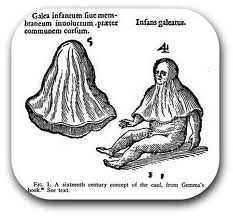In Superstitions of sea faring folk I mentioned a Caul
being used by sailors as a protection against drowning. But what is a Caul?
The Caul
Bearer.
Those babies born with a Caul are called Caul bearers
and in many cultures it is referred to as The Veil. The Caul is like a mask
that is found covering the face of some children at birth. The Caul is formed
from the membranes of the amniotic sac that develop during pregnancy which in
some cases covers the face and head of the baby. After the birth, the caul would be carefully
removed from the newborn, taking care to keep it as intact as possible. It
would then be preserved and would be kept with the child as a protective
talisman. To be born with a Caul is an extremely rare occurance and because of
this such children were held in high regard and in some cultures feared.
Those born behind the veil can be male or female, rich
or poor. They can be from any social, religious or racial group and from any
country. There are no barriers when it comes to the Caul Bearers although there
may be a genetic tendency so in rare cases there may be more than one member of
a family born with a Caul.
There has been some suggestion that these births may
be as few as one in a hundred thousand but there has been no definitive study
carried out to my knowledge in regard to geographical area or population group.
It has also been suggested that one of the reasons why
those born with a Caul are held in high esteem is due to the fact that the time
and place of a birth can be predicted. In some cultures the Caul Bearer was
considered to be King by right due to the predictive nature of their birth and
because they were thought to have great leadership qualities. There are a
number of Buddhist groups who will seek out Caulbearers to be reared as a
future Dalai Lamas.
Caulbearers are thought to have special abilities
which include the ability to find hidden underground water supplies, knowing
when the weather will change and predicting future harvest size and where to
fish. They are also known to be great
healers who can heal either by laying on of hands or from a far distance
(Remote healing). Because of their ability to see beyond the veil they were
thought to have second sight and so were able to predict the future. They were
also considered to be knowledgeable in matters of judgement and leadership and
they are highly respected by many cultures.
However, as I said at the beginning some people and
groups feared the Caul bearer and there have been many attempts throughout
history to destroy them. Some powerful groups feared the Caul Bearers because
they saw them as messengers of a higher force sent to guide mankind in
spiritual matters and in times gone by they were held in such high regard for
their wide range of knowledge they were looked upon as priests and teachers,
this was long before the idea of religious priests was an accepted term. This
period of persecution was known as The Veil of Tears and was at its height
during the Middle Ages when Caul bearers were burned as witches and heretics
mainly by the Church of Rome.
Persons of negative character may often react to
Caulbearers at a very subconscious level as they sense that there is something
different about these people. There are many folk tales about “the curse of the
Caul” which appears to come from the fallout of negative actions against a
bearer of the Caul. This persecution was
to receive support from both the ruling class who wished to obtain power
through might rather than birthright and the ignorant who were easily led as
they feared the unknown and those who were seen as different made easy targets.
Nothing much has changed.
Returning to the superstition of sea faring folk. It
was believed that children born with the
Caul would never die of drowning and they would make good sailors. In Victorian times Cauls were even sold at
auction and fetched very good prices as they were often bought by seafarers who
wished to obtain protection against the dangers of the sea.

No comments:
Post a Comment